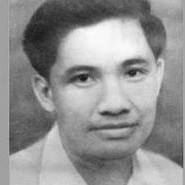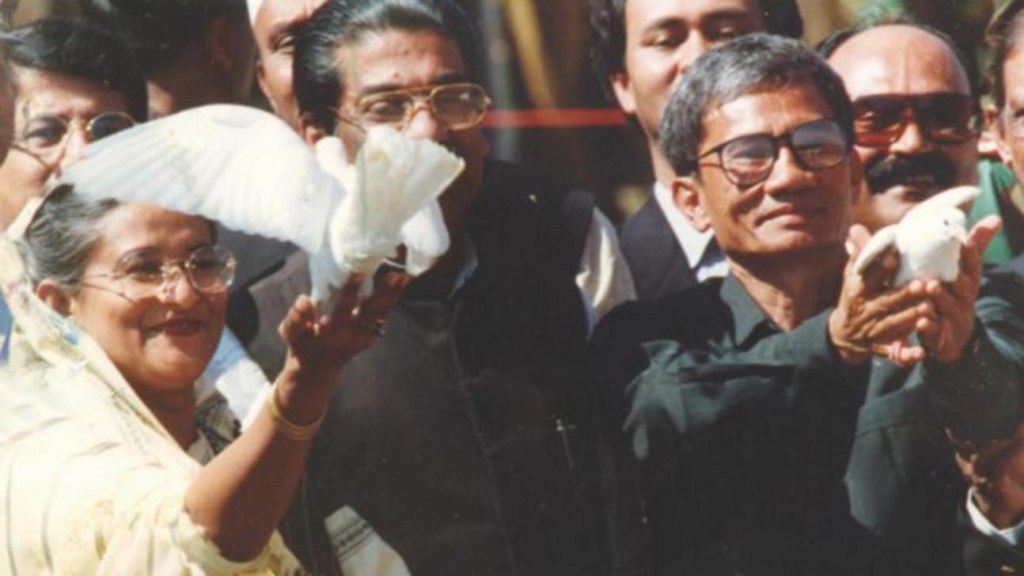(The Mog Nation Wiki, an archive)
The Shanti Bahini (Bengali: শান্তি বাহিনী; meaning “Peace Force”) was the armed wing of the Parbatya Chattagram Jana Samhati Samiti (United People’s Party of the Chittagong Hill Tracts) in Bangladesh. It is considered an insurgent group in Bangladesh. The Shanti Bahini was made out of mostly members from the Chakma tribe, and some members of Marma tribe joined it as well.
Background
Shanti Bahini was declared to have been formed on 7 January 1973. The circumstances leading to the emergence of Shanti Bahini as an armed organisation dates back to the colonial and Pakistan period. At the initial stage of the establishment of British colonial rule the chakmas were engaged in a resistance movement for nearly ten years. The movement was aimed at getting recognition of the hill tracts as an autonomous region within the British kingdom. At the end of the nineteenth century, the people of Chittagong Hill Tracts again started armed struggle when their autonomy was interfered with. The Chittagong Hill Tract Ordinance was promulgated in 1900 in which the Chittagong Hill Tracts was declared as a special administrative area.
The sufferings of the hill people, consequent upon the implementation of the Kaptai Hydro-electric Project in 1960, created resentment among the Chakmas, who were the worst sufferers of the project. This resentment continued for a long time, and ultimately gave rise to the formation of a political party of their own to safeguard their interests. This party, styled as parbatya chattagram jana-samhoti samiti, was founded on 15 February 1972. But the immediate cause of the establishment of this party appears to have been the emergence of Bangladesh on the basis of Bangali nationalism. The hilly people called themselves Jumya, and they are not anthropologically Bengalis.
They demanded autonomy and placed before the awami league government the following 4-point demands in this regard: (i) declare Chittagong Hill Tracts as an autonomous zone with an Assembly of its own; (ii) incorporate provisions in the Constitution of Bangladesh similar to the Chittagong Hill Tracts Ordinance of 1900 AD; (iii) recognise and maintain the offices of the tribal kings, and (iv) incorporate provisions in the Constitution for safeguarding the autonomy of the Chittagong Hill Tracts.
In the light of these demands, Manabendra Narayan larma MP placed a demand in writing to the government to grant special administrative status to Chittagong Hill Tracts. But the Constitution did not provide any special political and administrative status to the Chittagong Hill Tracts. After having lost constitutional methods in mitigating the demands of the hilly people, Jana-Samhati Samiti under the leadership of Manabendra Narayan Larma resolved to solve the problem through armed struggle which was followed by the creation of an armed unit called Shanti Bahini.
Operationally, Shanti Bahini divided the Hill Tracts into several military zones (north and south), and each zone was divided into three sectors and the sectors into different areas. The headquarters of Jana-Samhati Samiti and of the Shanti Bahini was situated in the dense forest of Dighinala upazila of the present Khagrachhari district. By 1974, a considerable number of hill-people were given military training and were enrolled with the Shanti Bahini. Besides the regular force, a militia was formed with short training. In addition to the village panchayets a number of youth organisations and women associations were formed to help the Shanti Bahini and the militia.
Militant activities
Shanti Bahini began its armed operations in early 1976 and had been able to operate its activities in the area.
Shanti Bahini began attacking Bangladesh Army convoys in 1977.[6] They carried out kidnappings and extortion. Larma subsequently went into hiding from government security forces. Factionalism within the PCJS weakened Larma’s standing and he was assassinated on 10 November 1983. On 23 June 1981 the Shanti Bahini attacked a camp of Bangladesh rifles, killing 13 people. They later captured and executed 24 members of the Bangladesh rifles. In the 1980s the Government of Bangladesh started to provide land for thousands of landless Bengali . Many Bengali were forced to move to secure regions because of the insurgency, abandoning their land to the tribal communities. On 29 April 1986, Shanti Bahini massacred 19 Bengali. On 26 June 1989 the Shanti Bahini burned down villages where inhabitants had voted in Bangladeshi elections. In 1996 Shanti Bahini abducted and killed 30 Bengalis. On 9 September 1996, the Shanti Bahini massacred a group of Bengali lumberjacks, who were under the impression they’d been called to a meeting. Members of Shanti Bahini extracted some four million dollars from the local population in the name of toll collection.
Manabendra Narayan Larma continued to lead the Jana-Samhati Samiti and Shanti Bahini till his assassination on 10 November 1983.
Factional Split
After the death of Manabendra Narayan Larma, the Shanti Bahini split into two factions (Larma group and Preeti group) and were engaged in fatricidal conflicts. The Bangladeshi government declared amnesty and full governmental cooperation to the members of Shanti Bahini provided they decided to lead a normal life, surrender their arms and stop insurgency. Most of the leaders and members of the Shanti Bahini belonging to Preeti group surrendered to the government on 29 April 1985, while the Larma group continued to fight. Meanwhile, Bodhipriya Larma, a field commander of the Shanti Bahini, was elected president of Jana-Samhati Samiti (1985), and under him attempts for peace talks were initiated between the Shanti Bahini and the Bangladeshi government.
The Surrender
The elected Bangladeshi government, of the period 1991-1996, continued the peace process initiated by all previous governments. Finally, the following elected government (1996-2001) signed the Chittagong Hill Tracts Peace Accord with the Shanti Bahini/the PCJSS on 2 December 1997. The Shanti Bahini was formally abolished by a declaration in the sixth convention of Jana-Samhati Samiti held in 1999.
Members of Shanti Bahini surrendered their weapons in a stadium in Khagrachari. The treaty saw the lifting of nighttime curfew and the return of 50 thousand refugees. However, some members opposed to the peace deal formed a dissident group. Some of those who opposed the peace treaty formed the United People’s Democratic Front as an alternate to the PCJSS. The treaty was also criticised by the Bangladesh Nationalist Party and has not been fully implemented.
End Notes/External Links
- Shanti Bahini | Wikipedia
- Shanti Bahini | Banglapedia
- Last updated on 4th January 2022



The Mog Nation Wiki
Kyaw Zaw Oo
- Kyaw Zaw Oo’s Blog
- Kyaw Zaw Oo | Facebook
- ကျော်ဇောဦး | Facebook
- Kyaw Zaw Oo | Twitter
